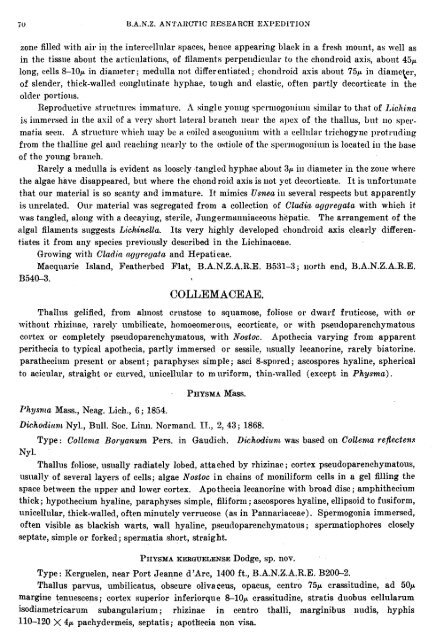Create successful ePaper yourself
Turn your PDF publications into a flip-book with our unique Google optimized e-Paper software.
7U B.A.N.Z. AN'I"11lC'TIC 1lESEAR.CII ESPEL)ITION<br />
zone filled with air ii! the intercrllular spaces, hence appearing black in a fresh mount, as well as<br />
in the tissue about the articulations, of filaments perpendicnlar to the chondroid axis, abont 4Sp<br />
long, cells 8-lop in diameter; medulla not differentiated; chondroid axis about 75p in diamc er, t<br />
of slender, thick-walled conglntinate hyphae, tough and elastic, often partly decorticate in the<br />
older portions.<br />
Reproductive structurcs immature. h single young rpc1rniogol~ium similar to that of 1,iclti?ln<br />
is immersed ia the axil of a very short latcbral branch near the apes of the thallus, but 110 spcrmatia<br />
seen. A structure which uiay bc it voiled ascogoninn1 wit11 :I celh~lar trichogyne l~rotruding<br />
from the tlialliiie gel and reaching nearly to the ostiole of the sl~er111ogo:iiluin is located i11 the base<br />
of the young branch.<br />
Rarely a medulla is evident as loosely tangled hyphae abol~t 3p i11 diameter in the zoiic where<br />
the algae have disappeared, but where the chond roid axis is liot yet decorticate. It is unfortunate<br />
that our material is so scanty and immature. It mimics Usnea ill several respects but apparently<br />
is unrelated. Onr material was segregated from a collection of Cldiil qgregata with which it<br />
was tangled, along with a decaying, sterile, Jungermanniaceous hepatic. The arrangement of the<br />
algal filaments suggests Lich~inella. Its very highly developed chondroid axis clearly differen-<br />
tiates it from any species previously described in the Lichinaceae.<br />
Growing with Cladin agyregata and Hepaticae.<br />
Macquarie Island, Featherbed Flat, B.A.N.Z.A.1E.E. B531-3 ; liorth end, B.A.N.Z.A.R.E.<br />
B540-3. ,<br />
COLLEMACEAE.<br />
Thallus gclified, from allnost crustose to squamose, foliose or dwarf fruticose, with or<br />
without rhiziilae, rarely umbilicate, homoeomerons, ecorticate, or with pse~~doparenchymato~~<br />
cortex or completely pseudoparenchymatous, with Nostcrc. Apothecia varying from apparent<br />
perithecia to typical apothecia, partly immersed or sessile, l~snally lecanorine, rarely biatorine.<br />
parathecium present or absent; paraphyses simple; asci 8-spored; ascospores hyaline, spherical<br />
to acicular, straight or curved, unicellular to m nriform, thin-walled (except in Physma).<br />
I'hysnta Mass., Neag. Licli., 6; 1854.<br />
PHYSMA Mass.<br />
Dichod,i~inb Nyl., Bull. Soc. Linn. Normand. IT., 2, 43; 1868.<br />
Type: Collen~a Roryanum Pers. in Gaudich. Dichditin~ was based on Collenza reflecte?~~<br />
Nyl.<br />
Thallus foliose, usually radiately lobed, attached by rhizinac; cortex pseudoparenchymatous,<br />
usnally of several layers of cells; algae h70stoc in chains of nioniliform cells in a gel filling the<br />
space between the upper and lower cortex. Apothecia lecanorine with broad disc; amphithecium<br />
thick; hypothecinm hyaline, paraphyses simple, filiform ; ascospores hyaline, ellipsoid to fusiform,<br />
unicellular, thick-walled, often minutely verrucose (as in Pannariaceae). Spermogonia immersed,<br />
often visible as blackish warts, wall hyaline, pseudoparenchymato~~s; spermatiophores closely<br />
septate, simple or forked; spermatia short, straight.<br />
PEIY~MA KERQUELENSE Dodge, sp. nov.<br />
Type: Kerguelen, near Port Jeanne d'Arc, 1400 ft., B.A.N.Z.A.R.E. B200-2.<br />
Thallus parvus, umbilicatus, obscure olivaceus, opacus, centro 75p crassitudine, ad 5%<br />
margine tenuescens; cortex superior inferiorque %lop crassitudine, stratis duobus cellularum<br />
isodiametricarum subangularium; rhizinae in centro thalli, marginibus nudis, hyphis<br />
110-120 X 4p paehydermeis, septatis; apotbecia non visa.

















